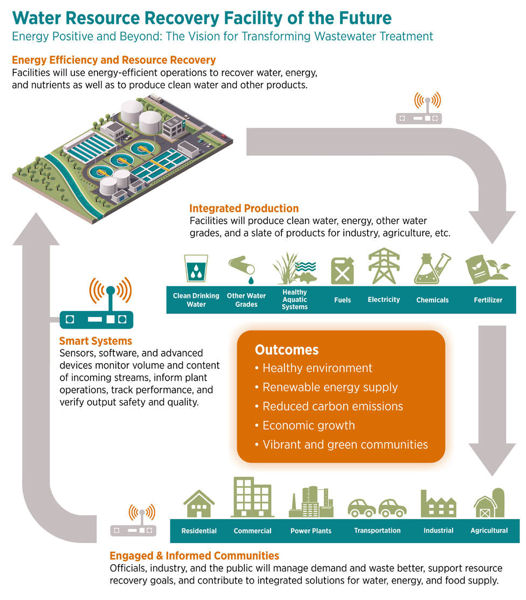
This graphic from the Energy-Positive Water Resource Recovery Workshop Report shows how energy efficient operations at water resource recovery facilities can produce water and other products. Photo courtesy of the National Science Foundation, U.S. Department of Energy, and U.S. Environmental Protection Agency, 2015.
A Nov. 3 report from the U.S. Department of Energy (DOE) promotes a change in terminology that was first publicly championed by the Water Environment Federation (WEF; Alexandria, Va.). It uses the term water resource recovery facility (WRRF) instead of wastewater treatment plant “at the behest of the water treatment community to reflect a shift in self-identification,” according to the Energy-Positive Water Resource Recovery Workshop Report. This change is intended to help WRRFs generate clean drinking water, biofuels, chemicals, and other water grades for specific uses.
WEF first publicly championed this terminology in January 2013 to “better focus on the products and benefits of treatment rather than the waste coming into such facilities,” according to “From the Editors: Setting New Terms” in WE&T. WEF’s change followed deliberation by a specially created task force, collaboration between WEF staff members, and approval by the WEF Board of Trustees in July 2012.
Listening to gathered experts
The Energy-Positive Water Resource Recovery Workshop Report summarizes discussions and ideas from an April 28–29 workshop supported by the National Science Foundation (NSF), DOE, and the U.S. Environmental Protection Agency (EPA). The goal of the workshop was “to envision a transition from the wastewater treatment facilities of today to a new generation of WRRFs nationwide and identify specific opportunities to stimulate and support this transition,” the report says.
In addition to DOE, EPA, and NSF, several other organizations from nongovernmental, academic, regulatory, and utility circles participated in the workshop.
Ed McCormick, 2014–2015 WEF president, offered the first keynote speech on Energy-Positive Water Resource Recovery Facilities during the workshop. McCormick previously served as manager of wastewater engineering at the East Bay Municipal Utility District (EBMUD; Oakland, Calif.), where he led the development and implementation of a renewable energy program. This program enabled EBMUD in 2012 to become the first WRRF in North America to be a net producer of renewable energy.
McCormick was followed by Dick Luthy, director of ReNUWIt (Stanford, Calif.), an interdisciplinary, multi-institution research center whose goal is to change how urban water is managed. Luthy, Silas H. Palmer Professor of Civil and Environmental Engineering at Stanford University (Palo Alto, Calif.), spoke about Energy-Positive Wastewater Treatment and Re-Use.
The remainder of the workshop consisted of panel sessions and break-out groups to enable the participants to share ideas and develop paths forward.
Identifying the reasons
The impetus for this evolution of the water sector stems from the impending need to re-invest in water infrastructure. According to EPA, water infrastructure nationwide will require about $600 billion over the next 20 years to continue operating reliably.
“A unique window of opportunity exists to apply new knowledge and technology to create an industry shift, from wastewater treatment to wastewater resource recovery. Such a shift offers the potential to reduce the financial burdens on municipalities, decrease stress on energy systems, cut air and water pollution, improve system resiliency to climate impacts, and support local economic activity,” the report says.
Spurring further work
The sponsoring agencies also intend for this report to stimulate further dialogue and accelerate the wide-scale advent of advanced WRRFs, a DOE release says.
The agencies already are addressing one workshop suggestion by identifying facilities to serve as potential test beds for new technologies.
DOE, EPA, and NSF are cooperating with the Water Environment Research Foundation (Alexandria, Va.) to develop a National Water Resource Recovery Test Bed Network and Facility Directory.








December 23, 2015
Technologies, WEF Resources & Efforts